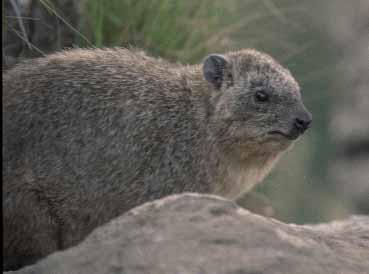
Geographic Range
Ethiopian: Syria south through NE Africa through most of sub-Saharan Africa. Isolated mountains in Libya and Algeria.
Physical Characteristics
In external appearance, hyraxes superficially resemble rabbits with short ears and tail. In all other respects, hyraxes are completely different from rabbits and are more closely related to elephants and other perissodactyls. The skull has a single pair of long, strong, tusk-like incisors and molars that resemble rhinoceros' molars. The feet are plantigrade (fore) to semi-digitigrade (hind). The soles of the feet have soft, large pads that are kept moist with sweat-like secretions. Male hyraxes are slightly larger than females (4kg vs 3.6kg). Measurements: Total length: 475-585mm; Tail length: 11-24mm; Hindfoot: 65-76mm; Ear 27-38mm.
Procavia capensis eats a wide variety of herbaceous plants, favoring giant lobelia and members of the genus Senecio. New shoots and fruits are the preferred diet, but grasses up to 75% of the diet during the dry season.
Reproduction
The breeding season in Kenya is probably August-November, but may extend into January. In Syria, breeding occurs from August-September and young are born mid-March through early May. Two to three young are born after a 6-7 month gestation period. The young are well-developed at birth with fully-opened eyes and complete pelage. Young can ingest solid food after 2 weeks and are weaned at 10 weeks. Young are sexually mature after 16 months, reach adult size at 3 years, and typically live about 10 years.
Behavior
Hyraxes live in herds of up to 80 individuals. These herds are subdivided into smaller flocks consisting of a few families and headed by an adult male. Hyraxes spend most of their time resting in large huddles or basking alone. These behaviors probably serve to help regulate body temperature as hyraxes' body temperature fluctuates with ambient temperature (i.e. they are not strictly homeothermic).
Habitat
Cape hyraxes live in crevices and cavities in rock outcroppings. They do not burrow, but they will inhabit burrows of other animals including those of aardvarks and meerkats.
Biomes: temperate grassland, tropical scrub forest, tropical savanna & grasslands.
 cape hyrax |
Family Dendrohyrax dorsalis - (Tree Hyrax) Family Heterohyrax brucei - (Yellow Spotted Hyrax) Family Procavia capensis - (Cape Hyrax)<<<<<<<>>>>>>> ARTIODACTYLA CARNIVORA CETACEA CHIROPTERA DASYUROMORPHIA DERMOPTERA DIDELPHIMORPHI DIPROTODONTIA HYRACOIDEA INSECTIVORA LAGOMORPHA MACROSCELIDEA MICROBIOTHERIA MONOTREMATA NOTORYCTEMORPHIA PAUCITUBERCULATA PERAMELEMORPHIA PERISSODACTYLA PHOLIDOTA PRIMATES PROBOSCIDEA RODENTIA SCANDENTIA SIRENIA TUBULIDENTATA XENARTHRA
Email: eradani7@aol.com